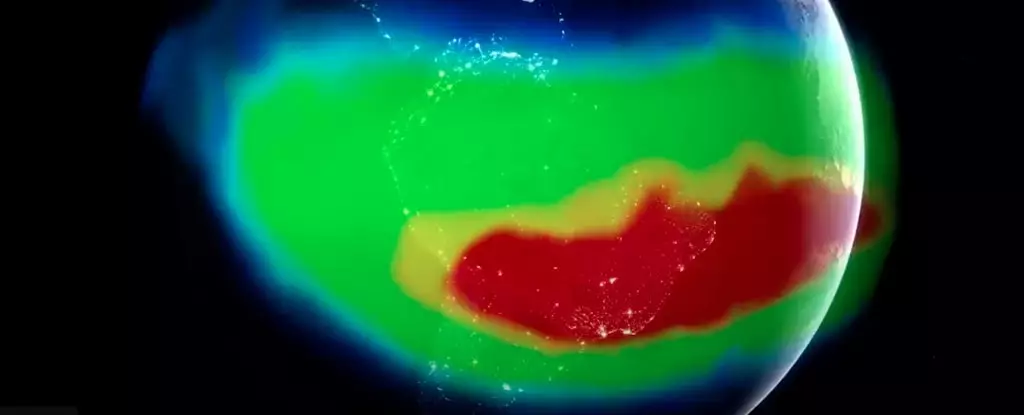The South Atlantic Anomaly (SAA) represents a significant area of interest for scientists studying Earth’s magnetic field. This peculiar phenomenon, which stretches between South America and southwestern Africa, is characterized by a notable decrease in magnetic intensity. NASA has dedicated substantial resources to monitor and research this anomaly due to its unique implications, especially for technologies operating in Earth’s orbit. Understanding the SAA goes beyond mere observation; it opens a gateway to uncovering the intricate workings of our planet’s magnetic field and its unpredictable behavior over time.
For NASA and other space agencies around the globe, the implications of the South Atlantic Anomaly are immense. Satellites and spacecraft that traverse the regions of the SAA face various risks stemming from its diminished magnetic strength. Electromagnetic interference from harmful cosmic radiation can lead to system faults, malfunctions, and even permanent damage to sensitive onboard instruments. For example, when satellites pass through the SAA, they encounter high-energy protons emitted by the Sun, which can disrupt their operation. As a precaution, satellite operators often preemptively shut down critical systems before entering the anomaly, underscoring the need for ongoing research and monitoring of this troubling magnetic region.
A pivotal element in understanding the SAA lies in exploring its cause. The phenomenon is believed to arise from the interactions between several geological and geophysical processes occurring deep within Earth’s interior. The magnetic field results from the movements of molten iron in the outer core, creating electrical currents. The composition and flow of this molten iron, however, are highly non-uniform, leading to areas of differing magnetic strength.
One of the culprits identified is a geological feature known as the African Large Low Shear Velocity Province. Located around 2,900 kilometers beneath the Earth’s surface, this dense rock formation is thought to disrupt traditional patterns of magnetic field generation. The distortion is further complicated by the tilt of Earth’s magnetic axis, leading to an uneven distribution of magnetic intensity. According to NASA’s geophysicists, the diminishing influence of the dipole field in this area is a critical factor contributing to the anomaly’s weakening effect.
As researchers delve deeper into the SAA, one remarkable observation has come to light: the anomaly is not static. Over time, studies have shown that it slowly drifts across the Earth, altering its shape and size. This movement was first suggested in 2016 and has since been affirmed by subsequent research utilizing advanced satellite tracking. However, even more fascinating is the discovery that the SAA appears to be splitting into two distinct regions, each characterized by its localized zones of minimal magnetic intensity. The implications of this division are still being studied, as scientists wrestle with the potential effects on Earth’s overall magnetic field dynamics.
Intriguingly, the South Atlantic Anomaly is not a recent phenomenon. Research indicates that similar magnetic disturbances have persisted for millions of years, complicating the narrative surrounding the anomaly’s significance. A study published in July 2020 suggests that the SAA has intermittently affected the planet’s magnetism for as long as 11 million years. This raises critical questions about whether the SAA contributes to larger geomagnetic phenomena, such as flips in Earth’s magnetic poles, which typically occur over extended periods.
The historical perspective on the SAA reassures scientists that its existence is not unprecedented but rather a recurrent occurrence in Earth’s geological time scale. However, the SAA’s current state and its gradual changes pique the curiosity of researchers who seek to understand the broader implications for our planet’s magnetic field stability.
As the SAA continues to evolve, it emphasizes the importance of sustained monitoring. NASA, equipped with cutting-edge technology and a team of dedicated scientists, is uniquely positioned to investigate this continuous anomaly. “Even though the SAA is slow-moving, it is going through some morphological changes, so it is important that we keep observing it through ongoing missions,” explains Terry Sabaka, a geophysicist at NASA. The persistent scrutiny of the SAA will not only aid in safeguarding space missions but will contribute to our broader understanding of how Earth’s magnetic field operates and changes over time.
The South Atlantic Anomaly serves as a vivid illustration of the complexities inherent in Earth’s magnetic field. Its impacts on space exploration and the accompanying scientific intrigue underscore the necessity for continued research. As we endeavor to decipher the mysteries of this magnetic enigma, we take another step in mastering our understanding of the world and the forces that govern it.


Leave a Reply